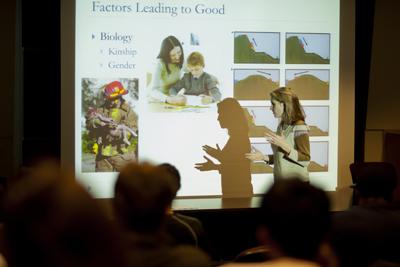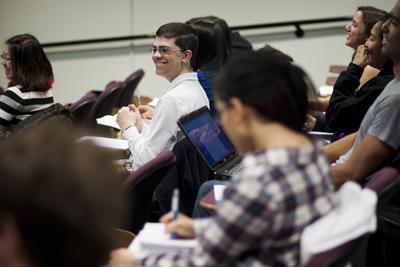By Katherine Duke ’05
Last year, a 2-year-old in Foshan, China, wandered into the road, where vehicles repeatedly struck her, and for a full 10 minutes thereafter, not one of the many passersby stopped to help the child; she died of her injuries a week later. In Guyana in 1978, hundreds of members of the “Jonestown Cult” fatally poisoned themselves and their children at the urging of leader Jim Jones. In the 1930s and 1940s, more than 23,000 non-Jews in at least 45 countries risked their lives to aid, hide and protect Jewish people, even as the Nazis were committing systematic mass murder.
 Photo by Alec Jacobson '12
|
What explains these kinds of events? What drives human beings to be so horrifically cruel and callous to one another—or so heroically helpful and generous? Professor of Psychology Catherine Sanderson shed some light on these complex questions in her new Interterm course, “The Psychology of Good & Evil.”
Through readings, discussions and video clips, the two-session course—based on a talk that Sanderson gave last year for an organization called One Day University—presented possible explanations of “good” and “evil” behavior as suggested by various psychological theories and studies. Among them was the infamous Milgram Experiment, which showed that ordinary people are very often willing to inflict pain on others (in this case, increasingly severe electrical shocks) if authority figures instruct them to. Before Stanley Milgram designed and carried out the study in the 1960s, the prevailing assumption “was that there are evil and bad people, and evil and bad people behave evilly, and other people do not,” Sanderson told the students. “[But] what seems to be the case is that it’s not really the person and who they are; it’s really about the situation—which means that all of us, or most of us, in this situation, could behave in a way that probably would not make us proud.”
Though Sanderson acknowledged that personality, gender and upbringing affect whether and how an individual is likely to do good or evil, the majority of the course focused on “the role of the situation in predicting behavior.” What images and words has the individual recently been exposed to? Where is the situation unfolding—in a small town or a big city? How many other people are around, and how are they reacting? What are the apparent risks and possible rewards to the individual if he or she responds, or doesn’t respond, in a certain way? Does the individual even know how best to help? Data from numerous studies tell us that all of these factors and more go into determining whether someone will, at a given moment, decide to act as a hero, a villain or a mere bystander.
 Photo by Alec Jacobson '12
|
But what factors contribute to the popularity of an Interterm course? “Psychology of Good & Evil” attracted some 50 students—about twice as many as Sanderson had planned for—in part because of her reputation and teaching style. “Professor Sanderson proved to be exactly the superb professor that all of the students here at Amherst say she is,” participant Morgan Brown ’15 wrote in an email. “Her energy and motivation were clear the moment I walked in and she exclaimed, ‘Hi! Welcome! Come on down and grab an outline!’ The content of the class was fascinating—specifically the … real-world examples…. The frequent and hilarious relevant personal anecdotes didn’t hurt either” (such as the one in which Sanderson confessed to responding with “a gesture that was not a wave” to an inconsiderate motorist in front of her at a fast-food drive-through).
“Sanderson will make even the most complex psychological theories easy to digest and memorable,” wrote Tracy Huang ’11, who is now in law school but returned to Amherst for Interterm. Huang took three courses with Sanderson, even though she wasn’t a psych major, and has kept in touch with her since graduating. A few months ago, she gave the professor a link to the video clip about the toddler in China, and Sanderson invited her to take “Good & Evil.” “She is very dedicated to her students, even those that have gone ‘beyond’ the Pioneer Valley. Because I was off-campus [in the weeks before the course], she sent me the readings by mail,” Huang wrote. She added that she found the most useful part of the course to be Sanderson’s applied-psychology lesson on the most effective ways to get help from a bystander in an emergency. (One tip: Pick out one particular person to ask for help—“You, ma’am, in the blue sweater!”—in order to avoid “diffusion of responsibility,” which is when everyone in a crowd assumes that it’s someone else’s job to take action.)
Sanderson is currently working on a book on the psychology of good and evil, and she plans to develop the Interterm course into a full-semester, for-credit course in the near future. Many students will agree: that’s good.